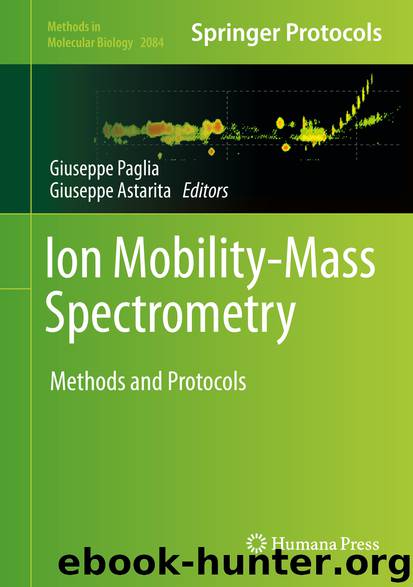Ion Mobility-Mass Spectrometry by Unknown

Author:Unknown
Language: eng
Format: epub
ISBN: 9781071600306
Publisher: Springer US
Key words
CyclosporineCyclosporine ADifferential mobility spectrometryMass spectrometryDMSDMS-MSBioavailabilityCell permeability
1 Introduction
Several key applications in the field of mass spectrometry involve the analysis of drugs, metabolites, as well as endogenous/exogenous compounds in matrices of varying complexity. Advances in liquid chromatography and integration with online or offline cleanup methods have greatly facilitated these analyses, frequently bringing down the analysis time to a few minutes. However, it remains that method development for analytes in complex matrices is challenging and can require sample cleanup steps prior to a long chromatography step. Hence, an analytical method such as differential mobility mass spectrometry (DMS-MS) capable of removing interfering electrospray ions and suppressing chemical noise, and remaining effective with reduced sample preparation can be of great utility. There are a number of recent applications of DMS-MS in the literature, and Sciex now offers the technology as SelexION on their time of flight and triple-quad systems. The most recent publications from our group, the Vouros group at Northeastern University, apply DMS-MS to radiation exposure biodosimetry [1, 2], to quantitation of cancer-linked DNA adducts [3], and to improve the understanding the DMS method [4]. Reviewing the extensive differential ion mobility literature must be omitted here, but an overview of the technology can be found in broader publications on differential mobility methods [5, 6] or in some of the many other journal articles [7–9].
Measuring the cell membrane permeability of different types of molecules is an important consideration in optimizing the drug delivery and evaluating the uptake of molecules by various cells. Caco-2 cells (human colon epithelial cancer cell line) are widely used as a model system for studying intestinal absorption of drugs and other compounds [10], and it has also been demonstrated that Caco-2 cells in transport media under culture conditions can be used to predict in vivo human absorption [11]. Hence, in vitro studies of drug candidates in Caco-2 cells have become standard in early phases of drug development to help streamline the selection of drug candidates [12].
Analysis of permeability studies for drug candidates comes with significant analytical challenges. The compound usually has to be detected at a low concentration in a matrix like Hanks’ balanced salt solution (HBSS) with additional HEPES buffer [11]. Furthermore, permeability is usually measured as a function of time which makes the throughput of the analytical technique important. Liquid chromatography with ultra-violet detector (LC-UV) has been widely used in permeability studies; however, the method largely depends on the absorbance of the analyte and matrix in the UV region. To overcome some of the detection issues using LC-UV, radioactive conjugates of the candidate molecules have been used in the permeability studies to enable detection [13], but radioactive labeling adds additional costs and necessitates special safety procedures during the synthesis, study, and disposal. While LC-MS has established itself as the preferred detection method for the free molecule in the complex buffer-based system, we found that obtaining a linear calibration cure required and additional pretreatment step like SPE , further increasing the time requirement. A rapid method eliminating sample cleanup steps prior to analysis could prove highly beneficial.
Download
This site does not store any files on its server. We only index and link to content provided by other sites. Please contact the content providers to delete copyright contents if any and email us, we'll remove relevant links or contents immediately.
| Automotive | Engineering |
| Transportation |
Whiskies Galore by Ian Buxton(41879)
Introduction to Aircraft Design (Cambridge Aerospace Series) by John P. Fielding(33064)
Small Unmanned Fixed-wing Aircraft Design by Andrew J. Keane Andras Sobester James P. Scanlan & András Sóbester & James P. Scanlan(32743)
Craft Beer for the Homebrewer by Michael Agnew(18140)
Turbulence by E. J. Noyes(7936)
The Complete Stick Figure Physics Tutorials by Allen Sarah(7307)
Kaplan MCAT General Chemistry Review by Kaplan(6867)
The Thirst by Nesbo Jo(6826)
Bad Blood by John Carreyrou(6552)
Modelling of Convective Heat and Mass Transfer in Rotating Flows by Igor V. Shevchuk(6391)
Learning SQL by Alan Beaulieu(6211)
Weapons of Math Destruction by Cathy O'Neil(6146)
Man-made Catastrophes and Risk Information Concealment by Dmitry Chernov & Didier Sornette(5921)
Digital Minimalism by Cal Newport;(5664)
Life 3.0: Being Human in the Age of Artificial Intelligence by Tegmark Max(5474)
iGen by Jean M. Twenge(5366)
Secrets of Antigravity Propulsion: Tesla, UFOs, and Classified Aerospace Technology by Ph.D. Paul A. Laviolette(5309)
Design of Trajectory Optimization Approach for Space Maneuver Vehicle Skip Entry Problems by Runqi Chai & Al Savvaris & Antonios Tsourdos & Senchun Chai(5011)
Pale Blue Dot by Carl Sagan(4912)
